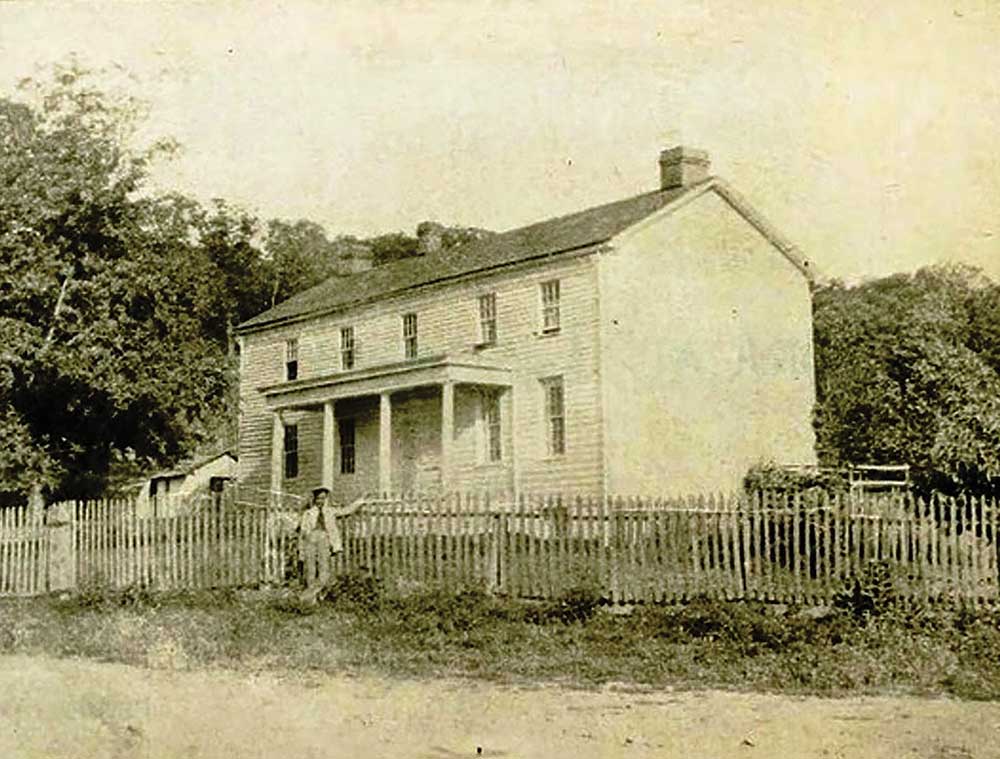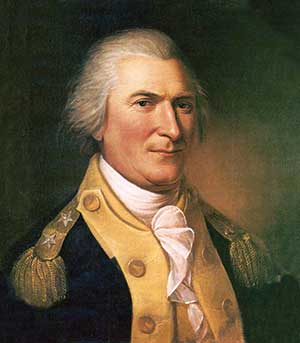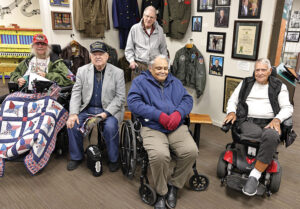
County named for Revolutionary War
soldier, American statesman
Story by Robert Debter
Submitted Photos
On Nov. 20, 1818, the Second Alabama Territorial Legislature representing 20 counties, seven of which had been created by the Mississippi Territorial Legislature (Washington, Madison, Baldwin, Clarke, Mobile, Monroe and Montgomery) and the remaining 13 (Morgan*, Lawrence, Franklin, Limestone, Lauderdale, Blount, Tuscaloosa, Marengo, Shelby, Bibb**, Dallas, Marion and Conecuh) established by the First Alabama Territorial Legislature earlier that year.
The first county created by the Second Territorial Legislature was taken from the northern portion of Shelby County and would bear the name of St. Clair.
A county older than the state itself draws its name from far away roots in Scotland. On March 23, 1734, at at Thurso Castle, in Thurso, County Caithness, Scotland, William and Margaret St. Clair welcomed a newborn son and bestowed the name, Arthur. After completing his formal education, he studied medicine at the University of Edinburgh and was apprenticed with Dr. William Hunter in England for a time. But like so many of his warrior ancestors, he heard the call of adventure and could not deny it.
In 1757, just in his early 20s, the young St. Clair purchased an ensign’s commission in the British Army and came to America during the French and Indian War, also known as the Seven Years War. He served in Canada during this almost decade-long conflict and was present at the Siege of Louisbourg.
For his heroism, Arthur was promoted to the rank of lieutenant (originally known as leftenant). The year 1759 saw the young soldier at the Battle of the Plains of Abraham in Quebec, where Lt. St. Clair seized the colors, which had fallen from the hand of a dying soldier and bore them until the day was won. In May of 1760, he married Phoebe Bayard of Boston, whom he had met while his regiment had been stationed there. They were joined in holy matrimony at Trinity Church in Boston. They would have 58 years and seven children together.
Two years after marrying, Lt. St. Clair resigned his commission and moved to Bedford, Penn., to survey land for the Penn Family. In 1764, the St. Clairs settled in Ligonier Valley, Penn., and through the establishment of several mills, St. Clair would eventually manage to become the largest landowner in western Pennsylvania. The parlor of his home, “The Hermitage,” remains preserved at the Fort Ligonier Museum.
He became surveyor of the Cumberland District in 1770, a justice of the court of quarter sessions and common pleas, a member of the proprietary council and justice, clerk and recorder of the Orphans’ Court.
In 1771, Gov. John Penn appointed him first prothonotary of Bedford County and deputy register for the probate of wills. Three years later, he was appointed magistrate and prothonotary of the newly established Westmoreland County. Penn described him as “… a gentleman … and in every station of life has preserved the character of a very honest, worthy man …”
Soldier, hero
St. Clair, commissioned as a colonel of a Pennsylvania regiment in 1776, raised and trained his regiment in the dead of winter and then marched six companies north to reinforce the American Army in Quebec. Unfortunately, St. Clair arrived to find the army in full retreat upon the death of Gen. Richard Montgomery, for whom the capital of Alabama is named. Col. St. Clair, through familiarity of the terrain and British strategy, saved the army from certain capture.
For his bravery, he was promoted to brigadier general and ordered to join Gen. George Washington and help him raise a militia in New Jersey. On Christmas night, St. Clair’s troops, now under the command of Washington, crossed the Delaware into Trenton and attacked the Hessians at dawn on the 26th. The Continental forces were victorious with 22 Hessian mercenaries killed, 84 wounded and 918 captured.
The empire struck back on Jan. 2, 1777, attacking Princeton and routing the small garrison that escaped over the Assunpink Creek to where Washington had posted several cannons. These cannons, along with musket fire, managed to stalemate the British forces.
That night, a council of war was called and many of Washington’s generals advocated for retreat. St. Clair’s lone voice championed attack. He proposed a daring plan to outflank the enemy and take Princeton. For this, St. Clair’s brigade was given the honor of marching ahead of the advancing army, and his battle plan resulted in a resounding victory for the Continental Army.
It was here that Arthur St. Clair and George Washington formed a strong bond that would last for many years. Even when some would later contest and question the Scotsman’s abilities, Washington, with one exception, always remained supportive and faithful to his friend.
St. Clair was promoted to major general for his “fierce bravery and loyalty” and given command of Fort Ticonderoga in New York. Previously a British stronghold, the fort had been captured in 1775 by Gens. Ethan Allen and Benedict Arnold “in the name of the Great Jehovah and the Continental Congress.” St. Clair arrived in early June 1777 and found the fort in disrepair. Worse yet, it was ill supplied and manned by a garrison of only 2,500.
Gen. John Burgoyne, “known more for his baggage train than his battles,” according to local historian Joe Whitten, laid siege to the fort with an impressive force of 8,000 British regulars and 2,500 auxiliary members.
Not seeing for the needless waste of life, St. Clair ordered the fort evacuated and later recounted, “I know I could have saved my reputation by sacrificing the army; but were I to do so, I should forfeit that which the world could not restore, and which it cannot take away, the approbation of my own conscience.”
The same cabal who endeavored to replace Washington as commander in chief with Horatio Gates lobbied strongly against St. Clair, decrying him as a “coward” and “traitor.” A court martial was convened, and the trial concluded with St. Clair being acquitted, “with the highest honor, of the charges against him.” Afterwards, naval hero Capt. John Paul Jones wrote to him, “I pray you be assured that no man has more respect for your character, talents, and greatness of mind than, dear General, your most humble servant.”
A leader
Following his vindication, St. Clair continued his active leadership. He commanded at West Point, suppressed a mutiny, continued raising troops and sending them south to aid Washington and Lafayette and served on the court martial that condemned Maj. John Andre, the co-conspirator of turncoat Benedict Arnold. He joined Washington at Yorktown four days before the surrender of Lord Cornwallis. In November, he was given orders to reinforce Gen. Nathanael Greene in his campaign to expel the British from the Carolinas.
Lawmaker
The general returned to Pennsylvania following the war and was elected to Congress in 1785. The Pennsylvania Herald reported, “Quorum having been formed in Congress, they proceeded to the choice of President for the ensuing year, when his Excellency Arthur St. Clair, Esq., was elected.”
During his 1787 term, the Northwest Ordinance was adopted, and the U.S. Constitution was drafted. In 1789, he had the great joy of assisting in the inauguration of his friend as the first president of the United States and had once been named as a possible candidate for the vice presidency.
From 1788 to 1803, St. Clair served as first governor of the Northwest Territory and named the city, Cincinnati, Ohio. His second-in-command, Winthrop Sargent, would serve from 1798-1801 as the first governor of the Mississippi Territory, from which Alabama was carved in 1817.
Return to duty
In 1791, St. Clair was once again called into action. As major general, he was tasked with suppressing Native-American resistance, and his force, originally consisting of 2,000, eventually dwindled down through illness and desertion to less than 1,000.
The combined forces of the Miami, Shawnee and Delaware numbered over 1,000 and on Nov. 4, 1791, ambushed the American force. St. Clair, ill with gout, suffered a devastating defeat, and the cries of cowardice and incompetence were once again revived.
Arriving at Philadelphia, St. Clair immediately requested a court martial to clear his name. This was denied by President Washington who called him “worse than a murderer” and demanded his resignation as commander of the Army. Meanwhile, the House of Representatives began an investigation and sided with Gen. St. Clair. They found secretary of war, quartermaster general and other officials in the War Department had ill manned, equipped and supplied Gen. St. Clair’s expedition. The Congress voted against a resolution on the committee’s report, so St. Clair was never officially vindicated.
He was allowed to remain governor – a position he found increasingly difficult following his humiliating forced resignation as commander of the Army. St. Clair, a Federalist, believed that the Ohio Territory should be admitted as two states instead of one to increase the power of his party in the federal congress.
He delivered a speech at the Ohio Constitutional Convention that railed against the Convention and President Thomas Jefferson, “acting like a father betrayed by his son, he used a paternalistic tone and discussed his contributions to the territory, outlining what he had accomplished in fourteen years ….” Jefferson responded by removing St. Clair from office.
Returning home
At almost 70 years of age, the old soldier returned to the Hermitage and facing debts from loans he had given out during the Revolution, attempted to rebuild his wealth. However, the stars in their courses fought against all his attempts to replenish his life, and sheriffs began to sell his property for all the debts he had incurred.
St. Clair beseeched Congress for money he was believed owed to him for his services to his country. The Hermitage was sold, and the St. Clairs moved to a log house called “Chestnut Ridge,” situated near Youngstown, Penn. Several months later, the legislature of Pennsylvania finally granted St. Clair an annuity of $8,400, and shortly before his death, he received from Congress $2,000 in discharge of his claims and a pension of $60 a month.
On his way to Youngstown to purchase goods, St. Clair was thrown from his wagon and found unconscious on the side of the road. He was tenderly carried back to his home, where he passed away surrounded by his family on Aug. 31, 1818, after a departing message of peace forevermore. By November of that same year, St. Clair County, Ala., would be created and bear his name.
Patriot
He was buried at the St. Clair Cemetery in Greensburg, Westmoreland County, Penn., and his monument, a gift from his Masonic brethren reads: “The Earthly Remains Of Major-General Arthur St. Clair Are Deposited Beneath This Humble Monument, Which Is Erected To Supply The Place Of A Nobler One Due From His Country.”
Always the patriot, in his own words: “I hold that no man has a right to withhold his services when his country needs them. Be the sacrifice ever so great, it must be yielded upon the altar of patriotism.” l
Editor’s Note: Of Alabama’s 67 counties, more than a dozen are named in recognition of those who have some connection as leaders, statesmen or soldiers to the American Revolution. Arguably, none gave so much and received so little in return as Arthur St. Clair. But his name lives on in this Alabama county.
* Originally “Cotaco [co-take-oh]” until renamed in 1821 for American Revolutionary leader, Brig. Gen. Daniel Morgan of Virginia.
** Originally “Cahawba” until renamed in 1820 for William Wyatt Bibb, territorial governor and first governor of the state of Alabama, shortly after his untimely death.




















